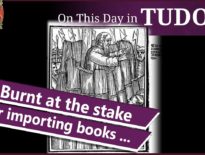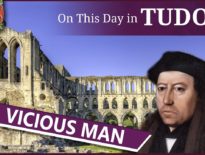On this day in Tudor history, 26th November 1585, Catholic priest Hugh Taylor and his friend Marmaduke Bowes were hanged at York.
They were the first men executed under Elizabeth I's 1585 statute which made it treason to be a Jesuit or seminary priest in England or to harbour such a priest.
These two Catholics were beatified in 1987 by Pope John Paul II as two of the 85 Martyrs of England, Scotland and Wales.
Find out more about these men and what this 1585 legislation was all about in today's talk.
Book recommendation: "God’s Traitors: Terror & Faith in Elizabethan England” by Jessie Childs.
Find out more about Elizabeth I's excommunication in this video:
Also on this day in Tudor history, 26th November 1533, Henry Fitzroy, Duke of Richmond and Somerset, the illegitimate son of King Henry VIII, married Mary Howard, daughter of Thomas Howard, 3rd Duke of Norfolk, at Hampton Court Palace. They were both fourteen years old.
It appears that the marriage, which was a political match rather than a love match, was the idea of Henry VIII's second wife, Anne Boleyn. You can find out more about the marriage and its context in last year’s video:
Also on this day in history:
- 1542 (26th or 27th November) – Death of Robert Radcliffe, 1st Earl of Sussex, courtier, soldier and Lord Great Chamberlain of England. He was buried at St Laurence Pountney Church in London, but then moved to Boreham in Essex. Radcliffe was made Lord Great Chamberlain of England for life on 3rd May 1540 for his loyal service to Henry VIII.
- 1546 – Baptism of Sir Giles Fletcher the Elder, diplomat, member of Parliament and author, in Watford, Hertfordshire. Fletcher was the son of Richard Fletcher, Church of England clergyman, and his wife, Joan. Fletcher is known for his poetical work, “Licia” (1593), but his other works included the Latin pastorals Poemata varii argumenti, the poem De literis antiquae Britanniae and the account of his travels as diplomat, “Of the Russe Common Wealth. Or, Maner of gouernement of the Russe emperour, (commonly called the Emperour of Moskouia) with the manners, and fashions of the people of that countrey”. He was the father of the poet Sir Giles Fletcher the Younger.
- 1612 – Death of Sir Thomas Walmsley, Judge and Justice of the Common Pleas, at his home at Dunkenhalgh in Lancashire. He was buried at Blackburn.
Transcript:
26 November
On this day in Tudor history, 26th November 1585, Catholic priest Hugh Taylor and his friend Marmaduke Bowes were executed at York.
They were both hanged, and were the first men executed under the 1585 statute which made it treason to be a Jesuit or seminary priest in England, or to harbour such a priest. Both men were beatified in 1987 by Pope John Paul II as two of the 85 Martyrs of England, Scotland and Wales.
Let me tell you more about these Catholic martyrs…
• Hugh Taylor was a Durham man who went to the English College, a seminary college, at Rheims in May 1582 and became ordained as a priest.
• In March 1585 he returned to England, having been sent there on a mission to convert people to what he viewed as the true faith, Catholicism. However, he was apprehended in York when a search was done of a Catholic man’s house, and it appears that the house belonged to Marmaduke Bowes, who was harbouring the priest.
• Bowes was married with children, for whom he had employed a Catholic tutor. He also harboured priests.
• Taylor and Bowes were condemned at York Castle on 24th November 1585 by the Commissioners of the North, and they went to their deaths on Friday 26th November 1585.
• In “Lives of the English Martyrs”, Edward Burton and J H Pollen quote an account of the execution by a Father Grene:
“At York, Mr. Taylor, having received sentence of death with a layman on a Thursday and on the following day, Friday, having said Mass and his office; ' How happy,' said he, ' should I be, if on this day, on which Christ died for me, I might encounter death for Him '. Scarcely had he said this when the officer unexpectedly came to lead him off to execution, and leaving the layman for Saturday (the usual day for executions) put him immediately to death.”
The layman mentioned here as dying the next day is Bowes, but some sources state he was executed with Taylor on 26th.
• Taylor was the first priest to suffer under the act against seminary priests and Bowes was the first layman to suffer for harbouring a priest.
• Elizabeth I and her government had been forced to act against Jesuits and those who helped them following her excommunication in 1570 by Pope Pius V. The pope not only excommunicated the queen, he absolved Catholics from any oaths they had made to her and called on them to disobey her orders, mandates and laws, and threatened excommunication for those who did obey her. This made Jesuits sent on missions to convert English people to Catholicism a real danger and enemies of the state.



Leave a Reply